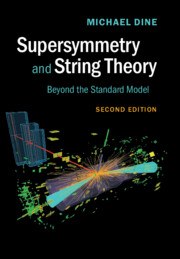Book contents
- Frontmatter
- Dedication
- Contents
- Preface to the First Edition
- Preface to the Second Edition
- A note on the choice of metric
- Text website
- Part 1 Effective field theory: the StandardModel, supersymmetry, unification
- Part 2 Supersymmetry
- Part 3 String theory
- 20 Introduction
- 21 The bosonic string
- 22 The superstring
- 23 The heterotic string
- 24 Effective actions in ten dimensions
- 25 Compactification of string theory I. Tori and orbifolds
- 26 Compactification of string theory II. Calabi–Yau compactifications
- 27 Dynamics of string theory at weak coupling
- 28 Beyond weak coupling: non-perturbative string theory
- 29 Large and warped extra dimensions
- 30 The landscape: a challenge to the naturalness principle
- 31 Coda: Where are we heading?
- Part 4 Appendices
- References
- Index
24 - Effective actions in ten dimensions
from Part 3 - String theory
- Frontmatter
- Dedication
- Contents
- Preface to the First Edition
- Preface to the Second Edition
- A note on the choice of metric
- Text website
- Part 1 Effective field theory: the StandardModel, supersymmetry, unification
- Part 2 Supersymmetry
- Part 3 String theory
- 20 Introduction
- 21 The bosonic string
- 22 The superstring
- 23 The heterotic string
- 24 Effective actions in ten dimensions
- 25 Compactification of string theory I. Tori and orbifolds
- 26 Compactification of string theory II. Calabi–Yau compactifications
- 27 Dynamics of string theory at weak coupling
- 28 Beyond weak coupling: non-perturbative string theory
- 29 Large and warped extra dimensions
- 30 The landscape: a challenge to the naturalness principle
- 31 Coda: Where are we heading?
- Part 4 Appendices
- References
- Index
Summary
In ten dimensions, supersymmetry greatly restricts the allowed particle content and effective actions of theories with massless fields. Without gauge interactions there are only two consistent possibilities. These correspond to the low-energy limits of the IIA and IIB theories. These have N = 2 supersymmetry (they have 32 conserved supercharges). Because the symmetry is so restrictive, we can understand a great deal about the low energy limits of these theories without making any detailed computations. We can even make exact statements about the non-perturbative behavior of these theories. This is familiar from our studies of field theories in four dimensions with more than four supercharges. In ten dimensions, supersymmetric gauge theories have N = 1 supersymmetry (16 supercharges). Classically, specification of the gauge group completely specifies the terms in the effective action with up to two derivatives. Quantum mechanically, only the gauge groups O(32) and E8 × E8 are possible.
Eleven-dimensional supergravity
Rather than start with these ten-dimensional theories, it is instructive to start in eleven dimensions. Eleven is the highest dimension where one can write a supersymmetric action (in higher dimensions, spins higher than 2 are required). This fact by itself has focused much attention on this theory. But it is also known that the theory in eleven dimensions has a connection with string theory. As we will see later, if one takes the strong coupling limit of the Type IIA string theory, one obtains a theory whose low-energy limit is elevendimensional supergravity.
The particle content of the eleven-dimensional theory is simple: there is a graviton, gMN (44 degrees of freedom) and a three-index antisymmetric tensor field, CMNO (84 degrees of freedom); here M, N, O = 0, …, 9 are space–time indices. There is also a gravitino, ψM. This has 16 × 8 degrees of freedom. We have, as usual, counted degrees of freedom by considering a theory in nine dimensions, remembering that gMN is symmetric and traceless and that the basic spinor representation in nine dimensions is sixteen-dimensional (it combines the two eight-dimensional spinors of O(8)).
The Lagrangian for the eleven-dimensional theory, in addition to the Ricci scalar, involves a field strength for the three-index field, CMNO.
- Type
- Chapter
- Information
- Supersymmetry and String TheoryBeyond the Standard Model, pp. 340 - 346Publisher: Cambridge University PressPrint publication year: 2016



